Teotihuacan, Mexico, main structures c. 50–250 C.E. Speakers: Dr. Lauren Kilroy-Ewbank and Dr. Beth Harris
[0:00] [music]
Dr. Beth Harris: [0:00] We’re standing in the archaeological park of the ancient site of Teotihuacan.
Dr. Lauren Kilroy-Ewbank: [0:10] We’re about 25 miles northwest of Mexico City. The site of Teotihuacan is known as “the City of the Gods,” the name given to it by the much later Aztecs.
Dr. Harris: [0:20] They looked back at what was then in ruins, but thought of it as a sacred city.
Dr. Kilroy-Ewbank: [0:25] Sometime around the year 100 B.C.E., you have the beginnings of Teotihuacan. Then sometime between around 600 or 700 of the Common Era, things start to go awry here.
[0:40] When the Aztecs are making pilgrimages to this site much later from their capital city of Tenochtitlan, or Mexico City, they were amazed and impressed. They believed that this was the city where the gods lived. Where the Fifth Sun was created.
Dr. Kilroy-Ewbank: [0:55] They named this place, and they named the streets, and they named the buildings, but we don’t know the original names. This long avenue was named by the Aztecs as the Avenue of the Dead.
Dr. Kilroy-Ewbank: [1:03] Teotihuacan is a great mystery in many ways. We don’t know what language they spoke. We don’t know what they called themselves. We don’t have a written language that we know of. Even though we do know a lot about the city and the population of Teotihuacan, some of the basic foundational knowledge is lost to us. Temporarily, hopefully.
Dr. Harris: [1:25] From what we’ve found, from the art, from the archaeology, from the buildings, we can say that they were masters of city planning, that they built these fabulous temples, but we don’t see ruler portraits like we might see in [the] Olmec culture that’s a little bit earlier.
Dr. Kilroy-Ewbank: [1:38] What we find here at Teotihuacan [is a] clear centralized government. Whether a single ruler or a body of rulers, it’s unclear to us, but whoever was in control had enough power to organize labor to plan on this massive scale.
[1:56] Everything is so standardized. The city itself is very centralized and it’s planned on this grid plan. There was no precedent for this type of highly organized, centralized city.
Dr. Harris: [2:09] There must have been enough food that was grown and brought into the city. We’re talking about a highly organized hierarchical culture that could pull off monumental architecture over a period of hundreds of years.
Dr. Kilroy-Ewbank: [2:22] The fact that we don’t have this cult of personality, that we don’t have clear portraits, is amazing. It’s frustrating to us today because we want to read into these beautifully complex murals that you find all over the city.
[2:31] We want to see rulers. We want to see narratives that talk about the ideologies that are being conveyed to the population through a ruler or rulers. What we see in these murals instead are the main deities — some kind of storm god, some type of great goddess — animal figures like coyotes and jaguars, and warriors.
Dr. Beth Harris: [3:01] We see a relationship between the monumental architecture and the landscape around it. As we look toward the Pyramid of the Moon, the shape of it is echoed by the mountain behind it.
Dr. Kilroy-Ewbank: [3:02] Teotihuacanos, as we call them, as we don’t know what they called themselves, were clearly planning some of their structures in accordance with the natural environment, to almost create sacred landscape within the city itself.
Dr. Harris: [0:00] As we stand here and look out, we see three main pyramids.
Dr. Kilroy-Ewbank: [3:17] We have the Temple of the Moon at the far end of the Street of the Dead. The Pyramid of the Sun, a little bit further down to the side, and then the Pyramid of the Feathered Serpent much further down the Street of the Dead.
Dr. Harris: [3:33] The Street of the Dead ran four miles, so it’s quite long and it really must’ve felt like a real procession way toward this sacred building.
Dr. Kilroy-Ewbank: [3:41] If we were on the Street of the Dead, it’s about 135 feet wide, so you get this sense that you’re processing down this grand boulevard. It’s very impressive to be walking through this city.
Dr. Harris: [3:48] It makes the approach to it formal, and processional, and ritualized. When we look at the Pyramid of the Moon, it would’ve originally been even taller, with probably wood structures on top.
Dr. Kilroy-Ewbank: [4:03] We also have to imagine that all of these buildings would’ve been stuccoed and then brightly painted, so the city would’ve been extremely vibrant. Off the Street of the Dead, there are approximately 2,000 apartment complexes on this grid plan.
[4:13] A lot of the ones close to the Street of the Dead are more complex. We think that they were for elites, and they too are heavily decorated with things like mural paintings.
Dr. Harris: [4:27] We have to imagine something that looks entirely different than the ruins that we see today.
Dr. Kilroy-Ewbank: [4:28] We also have to imagine all the activities here, whether they’re ritual or merchant. Only a small portion of the site has been excavated. There are continuing excavations here. Archaeologists are finding amazing things on a regular basis, including a recent discovery of a tunnel under the Pyramid of the Feathered Serpent.
Dr. Harris: [4:46] We could know so much more than we know now. I hope we do.
[0:00] [music]
Metropolis
An impressive city of 125,000–200,000 inhabitants, by the 6th century, Teotihuacan was the first large metropolis in the Americas. Teotihuacan, as the city is called, is a Nahuatl name that means “the place where the gods were created” and was given by the Mexica (sometimes called Aztec) centuries after it was abandoned in the 7th century. The Aztecs attributed names and significance to its buildings but had no contact with this earlier culture. Very little is known of the people who built Teotihuacan, and as a result, much of our knowledge of the site, its art, and Teotihuacan culture is derived from Aztec sources. Largely created before 250 C.E., Teotihuacan is a testament to the ambition of its people, who built the first American city on a grid plan.
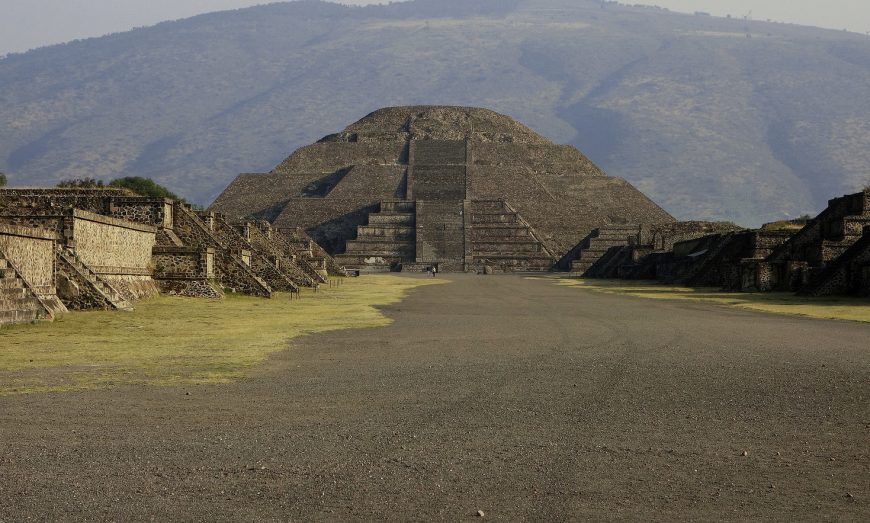
Pyramid of the Moon seen from the Avenue of the Dead with Cerro Gordo in the distance, Teotihuacan, Mexico (photo: Steven Zucker, CC BY-NC-SA 2.0)
Due to an absence of (or as of yet undiscovered) royal palaces and graves, the lack of evidence for a cult of personality, and the as-of-yet undeciphered hieroglyphs, the governing system of Teotihuacan remains largely elusive to scholars. Nevertheless, the dramatic monumental architecture and dense urban fabric reveal a complex environment carefully planned to support a large population but also structured by the surrounding natural environment and in relation to specific constellations and planetary events. In keeping with the stratified nature of other Mesoamerican societies, Teotihuacan also benefitted from rulers, or a ruling elite, who commissioned massive architectural landmarks such as the Pyramids of the Sun and Moon, and who spread Teotihuacan’s sphere of influence throughout Mesoamerica—even into the Maya region as far away as Guatemala.
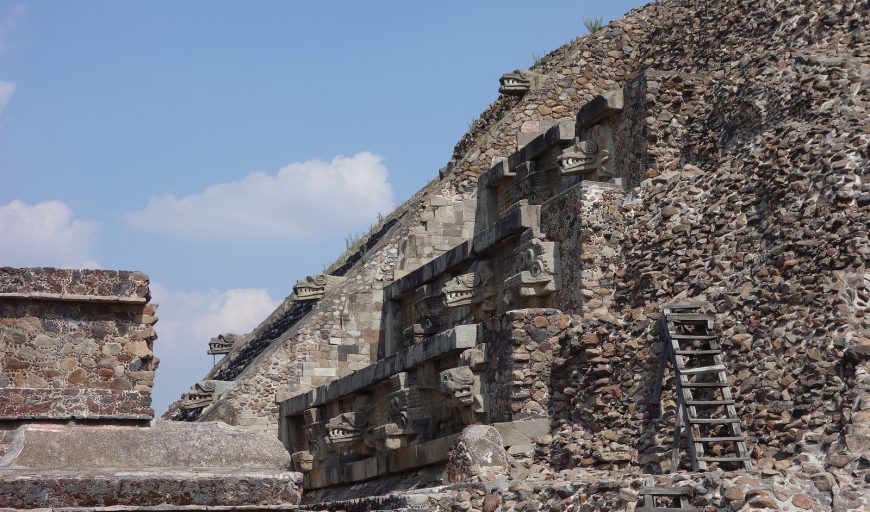
Pyramid the Temple of Quetzalcoatl (feathered serpent), Teotihuacan, Mexico (photo: Steven Zucker, CC BY-NC-SA 2.0)
Plan and pyramids
The city of Teotihuacan is aligned, like other Mesoamerican cities such as La Venta, on a north-south axis. This alignment is made explicit by the central artery, known as the Avenue of the Dead, which extends more than 1.5 miles across the city. Entering the city from the south, the Avenue of the Dead leads visitors to the city’s three main architectural monuments, the Ciudadela, a sunken plaza at the southernmost tip that contains temples, including the Pyramid of the Feathered Serpent, the Pyramid of the Sun further down the avenue, and the Pyramid of the Moon located at the northernmost point. In the distance and behind the Pyramid of the Moon, visitors can also catch a glimpse of the impressive Cerro Gordo, an extinct volcano that frames the pyramid and demonstrates the harmonious relationship between architecture and natural topography. Running perpendicular to the Avenue of the Dead, another street follows the San Juan River. These axes help to define the grid of intersecting horizontal and vertical corridors that structure and organize the city plan. The urban grid helped to establish order for religious, domestic, and commercial complexes and a structural coherence that supported the management of the city and its population. Thousands of apartment complexes also reflect the ordered planning of the site.
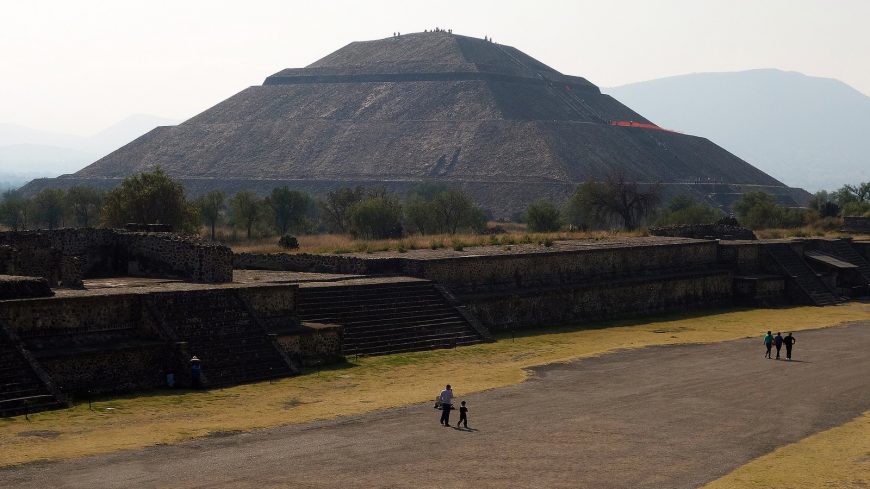
Pyramid of the Sun and the Avenue of the Dead, Teotihuacan, Mexico (photo: Steven Zucker, CC BY-NC-SA 2.0)
The Pyramid of the Sun, which reaches a height of over 200 feet, was the tallest structure in the Americas at the time. Built over a cave, it is unclear who or what the pyramid was built to commemorate, although art historians have suggested that creation mythology may be at issue, since Aztec and Maya sources refer to caves as places of origin and fertility. The pyramid was meant to be viewed and approached from the East. Visitors can still climb the pyramid’s steep staircase, which originates near the Avenue of the Dead and rises over five levels to what is now a bare flattened top. Keep in mind that this pyramid was heavily reconstructed in the modern era, so its original shape may have appeared somewhat differently than it does today.
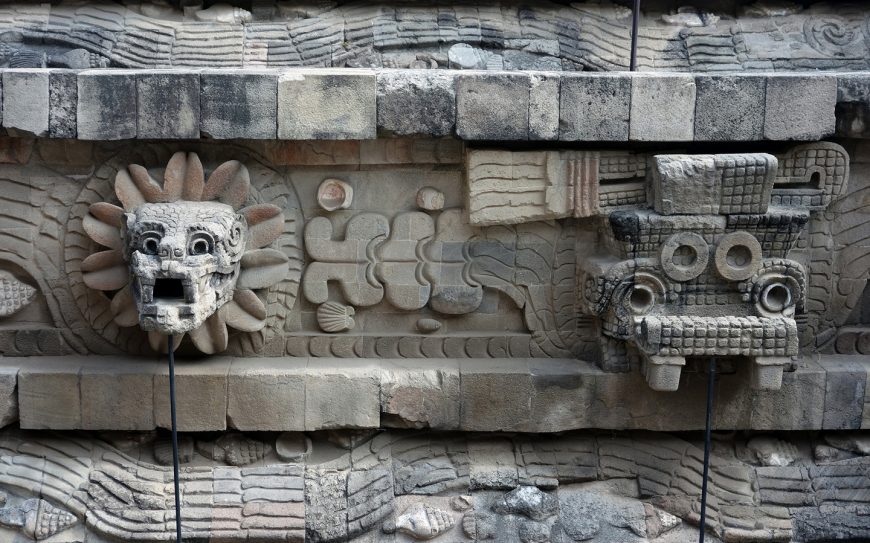
Pyramid of Quetzalcoatl (feathered serpent), Teotihuacan, Mexico (photo: Steven Zucker, CC BY-NC-SA 2.0)
The Pyramid of the Feathered Serpent occupies a prominent place in the Ciudadela, a large open space that offers a respite from the massive presence of the Pyramid of the Sun and Pyramid of the Moon. Like so much else at Teotihuacan, the Pyramid of the Feathered Serpent was built in the talud-tablero style. The temple stands out for its sculptural ornamentation depicting the feathered serpent, known by its Aztec name Quetzalcoatl. The feathered serpent is associated with water imagery and is depicted numerous times on the exterior of the temple as an undulating snake navigating among seashells. Two faces project outwards, one of which depicts the feathered serpent. The identification of the other head is more challenging. One interpretation is that it represents an early version of the Aztec god Tlaloc (known for his goggled eyes) and is associated with rain and warfare. However, some scholars identify the head as an early precedent of Xiuhcoatl, or Fire Serpent, who was associated with warfare, fire, and time (or the calendar). Most scholars agree that the temple was associated with warfare and human sacrifice, as confirmed by numerous skeletal remains (presumably of warriors) that were discovered by archeologists in the 1980s. Speculation has also arisen about whether the Pyramid of the Feathered Serpent may have contained the body of a ruler.
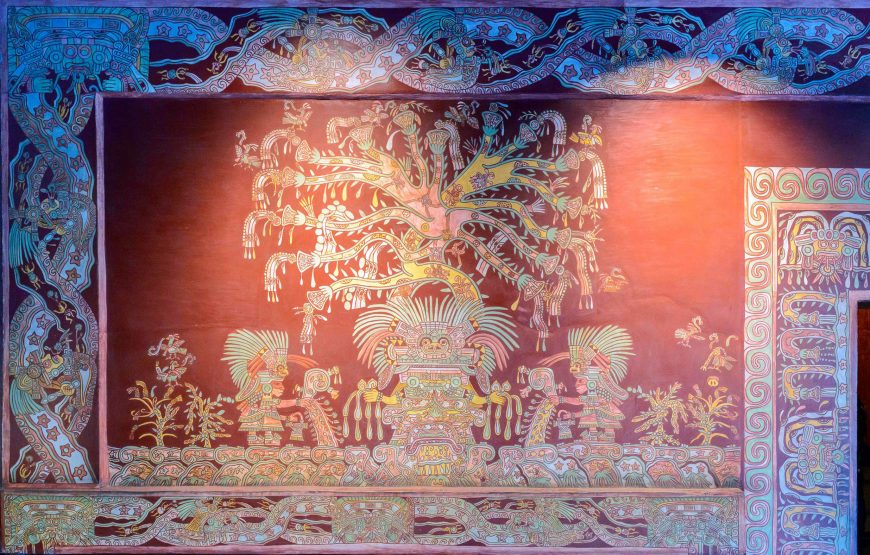
Agustín Villagra, reconstruction of mural from Tepantitla in Teotihuacan in the National Museum of Anthropology in Mexico City (photo: Steven Zucker, CC BY-NC-SA 2.0)
Paintings
Teotihuacan was a heavily painted site, with murals found throughout the city. For example, on the walls of the apartment complex in the Tepantitla district, we find an elaborate mural showing a figure often identified as the Great Goddess and, more recently, as a mountain-tree. The female figure stands frontally while a blossoming tree with butterflies and spiders emerges from her head (potentially a reference to the heavenly realm), while her feet remain attached to the underworld. The inverted u-shape found below the mountain-tree may function as a symbolic womb, similar to the cave found at the Pyramid of the Sun.
The identity of the two individuals to her side, possibly priests, have sparked interest. Considering the cosmopolitan nature of the city, it had been thought that Teotihuacan’s figurative art was not portraiture, but rather generic representations that sought to unify a diverse population. Recently, however, some painted signs have been recognized as representing the names of individuals, leading to a re-examination of whether Teotihuacan artists portrayed specific individuals and reminding us that there is still much to learn about this complex and ancient city.
Archeologists have dated the city’s collapse to the seventh century, when many of Teotihuacan’s buildings were destroyed.

